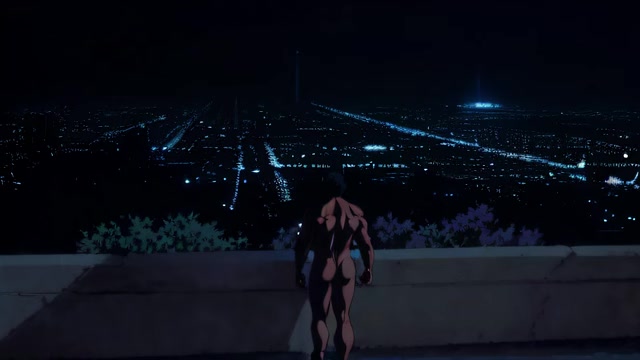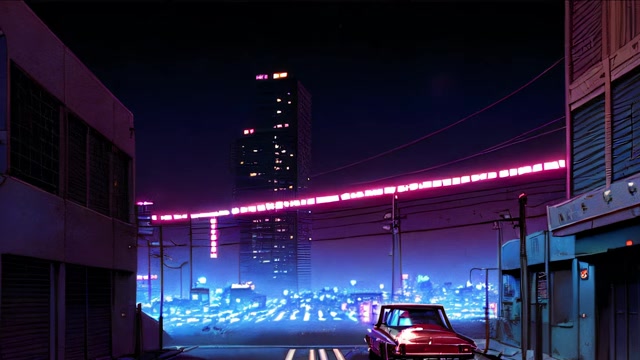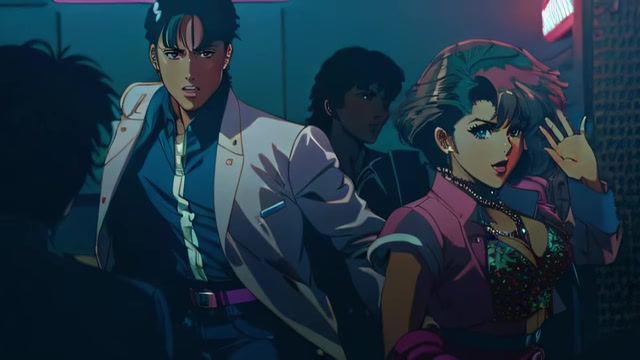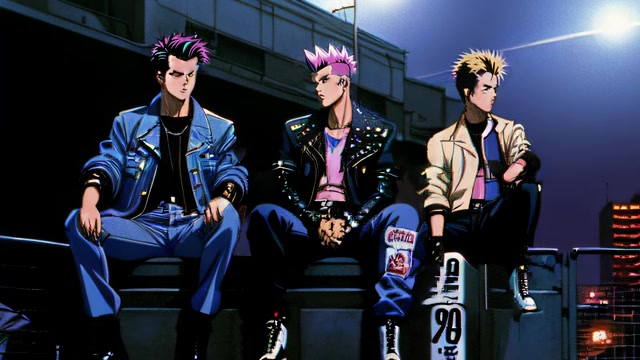
Key Points
Cyberpunk anime is characterized by a unique visual style, blending futuristic technology with urban decay.
Recurring themes include corporate dominance, social inequality, and the impact of technology on humanity.
Iconic elements include neon-lit cityscapes, cybernetic enhancements, and rebellious characters.
Notable cyberpunk anime titles showcase the genre’s diverse range and enduring appeal.
The aesthetics of cyberpunk anime extend beyond visuals, influencing music, fashion, and overall cultural expression.
Defining Cyberpunk Anime Aesthetics
What is Cyberpunk Anime?
Cyberpunk anime is a subgenre of Japanese animation (anime) that incorporates cyberpunk themes and aesthetics. Cyberpunk itself is a science fiction genre that typically features dystopian societies, advanced technology, social rebellion, and a general sense of unease regarding the future.

In cyberpunk anime, these elements are brought to life through distinctive visuals, complex characters, and narratives that often explore the dark side of technological advancement.
The term cyberpunk was coined by author Bruce Bethke in his 1983 short story of the same name. The genre gained prominence with works like William Gibson’s Neuromancer (1984) and Ridley Scott’s film Blade Runner (1982), which established many of the visual and thematic tropes associated with cyberpunk. Anime soon embraced these tropes, creating a rich and diverse body of work that continues to influence the genre today.
Cyberpunk anime is not just about cool gadgets and futuristic settings; it delves into profound questions about what it means to be human in an increasingly technological world. It questions the unchecked power of corporations, the widening gap between the rich and poor, and the potential for technology to both liberate and enslave humanity. These themes resonate with audiences who are increasingly concerned about the social and ethical implications of rapid technological change. The appeal is that there is a raw cyberpunk world, that the anime is unafraid to present a future that is not all sunshine and rainbows.
Visual Elements: High Tech and Low Life
One of the most striking aspects of cyberpunk anime is its visual aesthetic, which juxtaposes high-tech advancements with gritty, urban decay. Neon-lit cityscapes are a staple, with towering skyscrapers adorned with holographic advertisements and digital billboards.

These vibrant lights contrast sharply with the dark, rain-soaked streets below, where poverty and crime are rampant.
Cyberpunk worlds are often characterized by overcrowded cities, polluted environments, and dilapidated infrastructure. Flying cars weave through narrow alleyways, and holographic projections flicker amidst crumbling buildings. This contrast between the sleek and the seedy creates a visual tension that underscores the genre’s thematic concerns. The advanced technology is not evenly distributed; it is often concentrated in the hands of the wealthy elite, while the masses struggle to survive in the shadows.
The emphasis on visual detail is crucial to the cyberpunk aesthetic. Artists meticulously depict the intricate workings of cybernetic enhancements, the wear and tear on futuristic vehicles, and the grime that coats every surface. This attention to detail immerses viewers in the world, making it feel both fantastical and disturbingly real.
Here’s a breakdown of key visual components:
- Neon Lighting: Dominates the cityscape, creating a sense of artificiality and excess.
- Urban Decay: Dilapidated buildings, graffiti-covered walls, and overflowing garbage convey social breakdown.
- Advanced Technology: Cybernetic implants, holographic displays, and futuristic vehicles are integrated into everyday life.
- Rain and Darkness: Frequent rain and dark settings enhance the atmosphere of gloom and unease.
Recurring Themes: Dystopia and Rebellion
Cyberpunk anime is not just about visuals; it also explores a range of recurring themes that resonate with contemporary anxieties. Dystopian societies are a common setting, where corporations wield immense power, governments are corrupt, and individual freedoms are suppressed.

These societies often feature stark social inequality, with a small elite living in luxury while the majority struggle to make ends meet.
Social inequality is a central theme, highlighting the widening gap between the rich and poor in technologically advanced societies. The wealthy often control the means of production and distribution, exploiting the working class and perpetuating a cycle of poverty. This inequality fuels resentment and rebellion, as individuals and groups fight back against the oppressive system.
The impact of technology on humanity is another key concern. Cyberpunk anime often explores the ways in which technology can both enhance and diminish human life. Cybernetic enhancements can improve physical and mental capabilities, but they also raise questions about identity and autonomy. The proliferation of artificial intelligence raises fears about machines surpassing human intelligence and potentially threatening human existence.
Rebellion is a common response to these dystopian conditions. Characters often take up arms against the oppressive system, fighting for freedom, justice, and a better future. These rebellions can take many forms, from hacking into corporate networks to engaging in violent street battles. The protagonists are often flawed and morally ambiguous, blurring the lines between good and evil.
Here is a summary of common themes:
- Corporate Dominance: Corporations control governments and exploit society for profit.
- Social Inequality: Vast disparities in wealth and opportunity create tension and resentment.
- Technological Impact: Technology blurs the lines between human and machine, raising ethical questions.
- Rebellion: Individuals and groups fight back against oppressive systems.
- Loss of Identity: The increasing integration of technology threatens traditional notions of self.
Iconic Elements: Characters and Technology
Several iconic elements are consistently present in cyberpunk anime, contributing to its distinctive identity. Cybernetic enhancements are a hallmark, with characters often sporting robotic limbs, implanted interfaces, and other technological augmentations.

These enhancements can provide superhuman abilities, but they also come at a cost, both physical and psychological.
Rebellious characters are another key element. Protagonists are often hackers, mercenaries, or outlaws who operate outside the law, fighting against the oppressive system. They are typically skilled, resourceful, and fiercely independent, with a strong sense of justice.
Neon-lit cityscapes serve as the backdrop for these stories, creating a visually stunning and atmospheric setting. The cities are often teeming with life, but also fraught with danger, reflecting the social and economic disparities of the world. Here’s a rundown:
- Cybernetic Enhancements: Robotic limbs, implanted interfaces, and other augmentations are common.
- Rebellious Characters: Hackers, mercenaries, and outlaws fight against oppressive systems.
- Neon-Lit Cityscapes: Towering skyscrapers and rain-soaked streets create a distinctive setting.
- Artificial Intelligence: AI entities often play significant roles, raising questions about consciousness and autonomy.
- Hacking: Characters frequently use their tech skills to infiltrate systems and disrupt the status quo.
Notable Cyberpunk Anime Titles
Must-See Cyberpunk Anime Series
The cyberpunk anime genre includes many iconic titles. Each of these captures the spirit of cyberpunk in its own way:
-
Akira (1988): A landmark film that blends biker gangs, psychic powers, and government conspiracies in a futuristic Tokyo. Akira is known for its groundbreaking animation, intense action sequences, and thought-provoking themes.
-
Ghost in the Shell (1995): A philosophical exploration of identity, consciousness, and the nature of reality in a world where cybernetics are commonplace. Ghost in the Shell is celebrated for its complex characters, intricate plot, and stunning visuals.
-
Cowboy Bebop (1998): A stylish space western that follows a group of bounty hunters as they navigate a dangerous and unpredictable universe. While not strictly cyberpunk, Cowboy Bebop incorporates many of the genre’s themes and aesthetics, including advanced technology, social inequality, and moral ambiguity.
-
Serial Experiments Lain (1998): A surreal and unsettling series that explores the impact of the internet on identity, communication, and human connection. Serial Experiments Lain is known for its experimental visuals, complex narrative, and exploration of philosophical themes.
-
Psycho-Pass (2012): Set in a future where a ubiquitous system monitors and assesses citizens’ mental states, Psycho-Pass explores the themes of justice, free will, and the dangers of unchecked technological control. It is celebrated for its compelling characters, intricate plot, and thought-provoking commentary on social issues.
These titles represent just a small sampling of the many excellent cyberpunk anime series available. They showcase the genre’s diversity and its ability to explore a wide range of themes and ideas.
The Influence of Cyberpunk Aesthetics Beyond Anime
The aesthetics of cyberpunk anime have had a profound influence on popular culture, extending far beyond the realm of animation. The genre’s visual style, themes, and iconic elements have been adopted and adapted in numerous other media, including film, video games, literature, and fashion.
In film, cyberpunk aesthetics can be seen in movies like The Matrix (1999), Minority Report (2002), and Elysium (2013), which feature futuristic technologies, dystopian societies, and rebellious characters. These films draw heavily on the visual and thematic tropes established in cyberpunk anime, creating immersive and thought-provoking experiences for audiences.
Video games have also embraced cyberpunk aesthetics, with titles like Deus Ex (2000), Cyberpunk 2077 (2020), and Observer (2017) offering players the opportunity to explore sprawling urban landscapes, engage in cybernetic enhancements, and fight against oppressive corporations. These games often feature branching narratives and moral choices, allowing players to shape the story and explore the ethical implications of their actions.
The influence of cyberpunk aesthetics can also be seen in fashion, with designers incorporating elements like futuristic fabrics, asymmetrical cuts, and technological accessories into their collections. Cyberpunk-inspired fashion often combines functionality with style, reflecting the genre’s emphasis on practicality and individuality.
Here is a comprehensive look at how Cyberpunk Aesthetics influenced other mediums:
| Medium | Influence |
|---|---|
| Film | Dystopian settings, advanced technology, social rebellion, and iconic visual elements. |
| Video Games | Cybernetic enhancements, sprawling urban landscapes, oppressive corporations, and branching narratives. |
| Literature | Exploration of technological impact on humanity, social inequality, and the nature of identity. |
| Fashion | Futuristic fabrics, asymmetrical cuts, technological accessories, and a blend of functionality and style. |
| Music | Electronic Music, industrial sounds, and themes of technological alienation and social unrest. |
The enduring appeal of cyberpunk aesthetics lies in its ability to reflect and amplify contemporary anxieties about technology, society, and the future. By exploring the dark side of progress, cyberpunk anime and its related media offer a cautionary tale about the potential consequences of unchecked technological advancement and social inequality.
Modern Cyberpunk Fashion
Cyberpunk fashion is more than just a trend; it’s an expression of individuality in a world increasingly dominated by technology. Key elements include dark color palettes, utilitarian designs, and futuristic accessories. Think of it as practical clothing with a stylish, dystopian edge. You might see asymmetrical cuts, layered clothing, and functional accessories like tactical vests or tech-integrated outerwear.

These elements combine to create a look that is both edgy and practical, perfect for navigating a futuristic urban landscape.
Common materials in cyberpunk fashion include:
- Technical fabrics (ripstop nylon, Gore-Tex)
- Leather or pleather
- Mesh
- Reflective materials
Cyberpunk fashion is about more than just clothes; it’s a form of self-expression that allows individuals to showcase their unique identity and values. Whether you’re a seasoned cosplayer or simply looking to add a touch of futuristic flair to your wardrobe, cyberpunk fashion offers a wealth of inspiration and opportunities for creative experimentation. The key is to embrace the genre’s spirit of rebellion and innovation and create a look that is both stylish and authentic.
Pros and Cons of Cyberpunk Anime
Explores complex and relevant themes.
Offers visually stunning and immersive experiences.
Features compelling and morally ambiguous characters.
Influences numerous other media and art forms.
Encourages critical thinking about technology and society.
Can be dark, violent, and disturbing.
May require familiarity with Japanese culture and animation conventions.
Can be difficult to understand due to complex narratives and philosophical themes.
May perpetuate negative stereotypes about technology and the future.
Overuse of tropes can lead to predictability and lack of originality.
FAQ
What are the key characteristics of cyberpunk anime?
What are some recommended cyberpunk anime titles?
How has cyberpunk anime influenced popular culture?
Related Questions
What is the difference between cyberpunk and other science fiction genres?
How does Japanese culture influence cyberpunk anime?
What role does music play in cyberpunk anime aesthetics?
